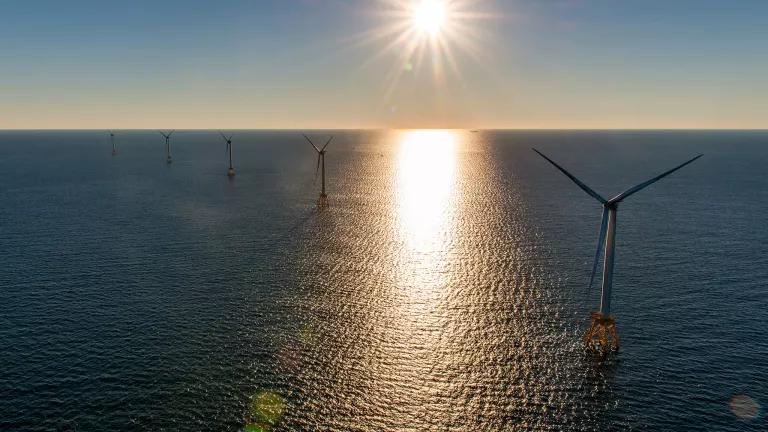Harris Amendment Imperils Offshore Wind Jobs

Why would Congressman Andy Harris (R-MD1) want to stand in the way of bringing clean, renewable offshore wind power to his home state of Maryland by trying to stop two projects that would create nearly 10,000 good jobs and revitalize Maryland’s ports? This is the question that Maryland citizens should be asking after Rep. Harris inserted an amendment into the 2018 House Interior-EPA spending package last week that would imperil the first two offshore wind projects that Maryland has approved.
With the support of Republican Governor Larry Hogan, Maryland is moving ahead with an ambitious offshore wind program. In May, after a lengthy review process that offered a wide range of opportunities for public participation, the Maryland Public Service Commission (PSC) gave the green light to two offshore wind projects to be located in federal waters off the Maryland and Delaware coasts. Environmentalists and many in Maryland’s business and labor communities have been big boosters.
The projects are being developed by two separate companies: U.S. Wind and Deepwater Wind. U.S. Wind plans a 248-megawatt project to be located at least 17 miles east of Ocean City, Maryland. Deepwater’s project would include 15 turbines and would be sited at least 19.5 miles from shore and 26 miles from the Ocean City Pier. Both projects will be subject to the federal government’s Bureau of Ocean Energy Management permitting and environmental review process. Together, they can generate enough renewable electricity to power more than 100,000 homes and can create almost 9,700 Maryland jobs. They can add $74 million in tax revenue over the next 20 years, will result in more than $1.8 billion in in-state investment, and will help make the area’s electric supply more reliable and resilient. As part of a package of conditions required by the Maryland PSC, U.S. Wind and Deepwater have also agreed to: (1) use port facilities in the Baltimore region and in Ocean City for construction, operations and maintenance; (2) a joint investment of at least $76 million in a steel fabrication plant in Maryland; and, (3) finance almost $40 million in upgrades to the Tradepoint Atlantic Shipyard in Baltimore County.
By jumpstarting offshore wind power in Maryland, these projects can help the state earn the important first-mover advantage in the growing offshore wind power industry that is now gaining traction along the East Coast. Last December, off Rhode Island, the nation’s first offshore wind power project came online, the Block Island Wind Farm. In Massachusetts, Republican Governor Charlie Baker has signed legislation that will bring 1,600 megawatts of offshore wind power to the Bay State by 2027. New York State plans to get 2,400 megawatts by 2030—enough to power 1.25 million homes. And Virginia is involved, too, with utility Dominion Energy Virginia two weeks ago announcing a plan to build a 12-megawatt project in nearby federal waters. Whichever state moves fastest and furthest in attracting the needed port and supply facilities will also be the first to reap the benefits from an industry that can employ as many as 160,000 by 2050, the U.S. Department of Energy estimates.
Rep. Harris’ rider would stop the use of federal funding for reviewing site assessments or construction plans for turbines located within 24 nautical miles of the Maryland shoreline. This would imperil at least one, if not both, of these projects. Harris maintains that the projects could impact tourists’ enjoyment of the beaches in Ocean City, Maryland. That’s hard to credit. Both projects will be located so far from shore that they will be hard to see under most conditions. And the Deepwater project, 26 miles northeast of Ocean City, will barely be visible, if at all. The Maryland Public Service Commission has already required U.S. Wind, the developer of the larger project, to locate its turbines as far away from shore as possible and has required that each developer to use the best available technology “to lessen views of the wind turbines by beach-goers and residents, both during the day and at night.” Any remaining concerns about visibility can be addressed as part of the upcoming federal environmental review and permitting process.
Maryland has crafted a well-thought-out, bipartisan plan to advance offshore wind responsibly, a plan the Harris amendment now endangers. But the harm from the amendment, if it becomes law, could be broader and impact the U.S. offshore wind industry as a whole by disrupting investor confidence. That would be a grave mistake. Both Republican and Democratic governors want to move forward with offshore wind power, as does U.S. Department of the Interior Secretary Zinke, who has called offshore wind “one tool in the all-of-the-above energy toolbox that will help power America with domestic energy, securing energy independence, and bolstering the economy.” Under Secretary Zinke’s watch, the federal government moved ahead this year with awarding offshore wind leases in the waters off North Carolina.
An irrational, last-minute amendment in a little-discussed appropriations bill shouldn’t stand in the way of the development of a major new source of American-made renewable energy, renewable energy that has a promising level of bipartisan support. Neither should this amendment jeopardize the infrastructure jobs that offshore wind power can create. Congress should ensure that Harris’ damaging amendment does not become law.



